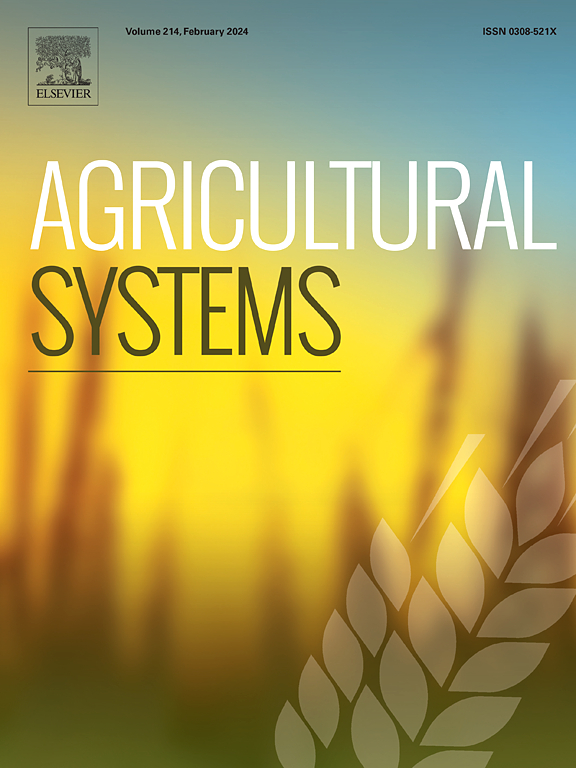Reintegrating livestock onto crop farms: A step towards agroenvironmental sustainability?
IF 6.1
1区 农林科学
Q1 AGRICULTURE, MULTIDISCIPLINARY
引用次数: 0
Abstract
CONTEXT
In Europe, the ever-increasing disconnection between crop and livestock production generates major environmental externalities. Opposing this trend, a few pioneering farmers have reintegrated (i.e. intentionally organized the return of) livestock onto crop farms. While often depicted as sustainable, these systems have rarely been researched.
OBJECTIVE
We aimed at assessing the agroenvironmental impacts of reintegrating livestock on crop farms and related farming-practice changes.
METHODS
Using an exploratory approach and innovation-tracking principles, we identified 15 crop farmers who had reintegrated livestock in farming systems that differed in production mode, farm size, crop and livestock species, and the type and duration of reintegration. We interviewed these farmers to characterize how their farming practices changed after reintegrating livestock. We then estimated impacts of their farming-practice changes after reintegrating livestock on nitrogen surplus, direct and indirect energy consumption and greenhouse gas emissions (including compensation through carbon storage) at the farm level on a yearly basis.
RESULTS AND CONCLUSIONS
Reintegrating livestock increased mean (± 1 standard deviation) farm-level nitrogen surplus (+25 ± 38 kg N/ha/year), energy consumption (+4913 ± 10,592 MJ/ha/year) and greenhouse gas emissions (+940 ± 1856 kg CO2 eq/ha/year), especially when reintegrating poultry (+58 ± 45 kg N/ha/year, +15,186 ± 13,954 MJ/ha/year and + 2707 ± 2474 kg CO2 eq/ha/year, respectively), as the overall aim was to increase farm economic performance. Interactions between crop and livestock production remained limited. The systems that reintegrated poultry relied on large amounts of feed input and did not decrease the amount of fertilizers purchased once poultry manure became available. Reintegrating sheep was associated with lower environmental impacts, with nearly no change in farm nitrogen surplus (+9 ± 28 kg N/ha/year), decreased energy consumption (−224 ± 203 MJ/ha/year) due to grazing cover crops or between orchard/vineyard rows and nearly no impact on greenhouse gas emissions (+56 ± 198 kg CO2 eq/ha/year) due to decreased mechanized operations and conversion of cropland into pasture, which mitigated livestock-related emissions.
SIGNIFICANCE
This original preliminary provides insights on the potential of reintegrating livestock to promote farm agroenvironmental sustainability when farmers subsequently change practices to increase interactions between crops and livestock (e.g. adjusting fertilization strategies, introducing legume-dense pastures into crop rotations to feed livestock). By providing a range of agroenvironmental impacts reachable through reintegrating livestock and documenting examples of farms having sustainably reintegrated livestock, it supports communication to farmers and policy makers to sustain scaling up of agroecological pathways to reintegrate livestock. It needs being completed with future assessments of socioeconomic impacts of livestock reintegration.

将牲畜重新纳入农作物农场:迈向农业环境可持续性的一步?
摘要在欧洲,作物和畜牧业生产之间日益脱节,造成了严重的环境外部影响。与这一趋势相反,一些先驱农民将牲畜重新融入(即有意组织牲畜回归)作物农场。我们采用探索性方法和创新跟踪原则,确定了 15 位将牲畜重新纳入农耕系统的农户,这些农户的生产模式、农场规模、作物和牲畜种类以及重新纳入的类型和持续时间各不相同。我们对这些农民进行了访谈,以了解他们的耕作方式在重新整合牲畜后发生了哪些变化。然后,我们按年度估算了他们在重新整合牲畜后的耕作方式变化对氮盈余、直接和间接能源消耗以及农场层面的温室气体排放(包括通过碳储存进行补偿)的影响。结果和结论整合牲畜增加了农场一级的平均(± 1 个标准差)氮盈余(+25 ± 38 千克氮/公顷/年)、能源消耗(+4913 ± 10592 兆焦/公顷/年)和温室气体排放(+940 ± 1856 千克二氧化碳当量/公顷/年)、由于总体目标是提高农场经济效益,在重新整合家禽生产时尤其如此(分别为+58±45千克氮/公顷/年、+15,186±13,954兆焦/公顷/年和+2707±2474千克二氧化碳当量/公顷/年)。作物生产与畜牧生产之间的相互作用仍然有限。重新整合家禽的系统依赖于大量的饲料投入,而且一旦有了家禽粪便,也不会减少化肥的购买量。养羊对环境的影响较小,农场氮盈余几乎没有变化(+9 ± 28 千克氮/公顷/年),能耗减少(-224 ± 203 兆焦/公顷/年),原因是放牧覆盖作物或在果园/葡萄园行间放牧,对温室气体排放几乎没有影响(+56 ± 198 千克二氧化碳当量/公顷/年),原因是机械化作业减少,耕地转为牧场,减轻了与牲畜有关的排放。意义这项原创性的初步研究提供了一些见解,说明当农民随后改变做法以增加作物与牲畜之间的相互作用时(如调整施肥策略、在作物轮作中引入豆科植物密集的牧草以喂养牲畜),重新整合牲畜有可能促进农场农业环境的可持续性。通过提供一系列可通过重新整合牲畜实现的农业环境影响,并记录可持续地重新整合牲畜的农场实例,它有助于与农民和政策制定者沟通,以持续扩大重新整合牲畜的农业生态途径。今后还需要对牲畜重返社会的社会经济影响进行评估,以完成该项目。
本文章由计算机程序翻译,如有差异,请以英文原文为准。
求助全文
约1分钟内获得全文
求助全文
来源期刊

Agricultural Systems
农林科学-农业综合
CiteScore
13.30
自引率
7.60%
发文量
174
审稿时长
30 days
期刊介绍:
Agricultural Systems is an international journal that deals with interactions - among the components of agricultural systems, among hierarchical levels of agricultural systems, between agricultural and other land use systems, and between agricultural systems and their natural, social and economic environments.
The scope includes the development and application of systems analysis methodologies in the following areas:
Systems approaches in the sustainable intensification of agriculture; pathways for sustainable intensification; crop-livestock integration; farm-level resource allocation; quantification of benefits and trade-offs at farm to landscape levels; integrative, participatory and dynamic modelling approaches for qualitative and quantitative assessments of agricultural systems and decision making;
The interactions between agricultural and non-agricultural landscapes; the multiple services of agricultural systems; food security and the environment;
Global change and adaptation science; transformational adaptations as driven by changes in climate, policy, values and attitudes influencing the design of farming systems;
Development and application of farming systems design tools and methods for impact, scenario and case study analysis; managing the complexities of dynamic agricultural systems; innovation systems and multi stakeholder arrangements that support or promote change and (or) inform policy decisions.
 求助内容:
求助内容: 应助结果提醒方式:
应助结果提醒方式:


